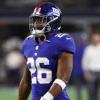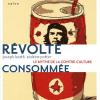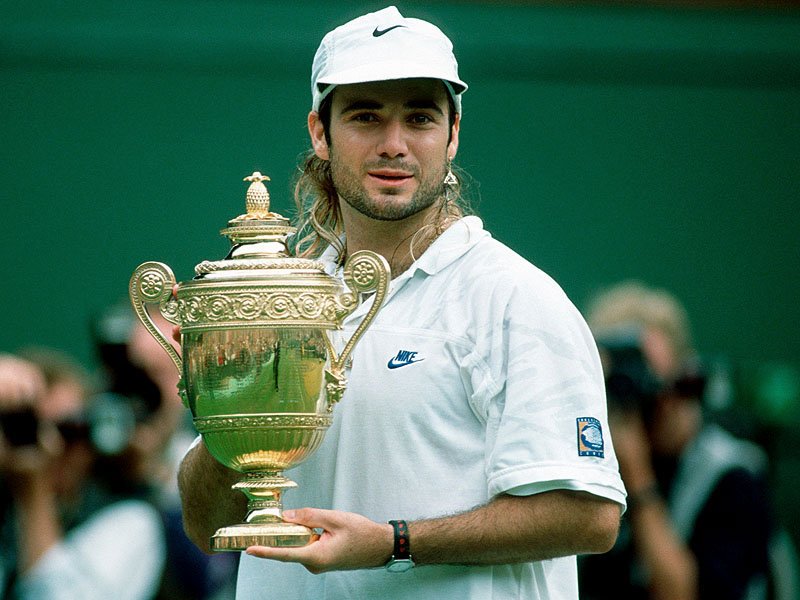
Istorija tenisa
#91

Posted 01 May 2017 - 18:44
(slatko dete, ali baš dete)
#92

Posted 01 May 2017 - 18:58
Ja samo kazem da je "simetricna", tj. spada u kategoriju lepih devojaka.
#93

Posted 05 July 2017 - 14:24
This Day In Tennis @ThisDayInTennis 58m58 minutes ago
July 5, 1992: Andre Agassi wins his first major singles title beating Goran Ivanisevic 6-7 (8), 6-4, 6-4, 1-6, 6-4 in the #Wimbledon final
#94

Posted 12 July 2017 - 11:31
Why tennis establishment shunned Fred Perry, Britain's previous Wimbledon men's winner in 1936
http://www.independe...36-8693754.html
Born in Stockport in 1909, he was the world number one for three years, taking in four Davis Cup wins for Britain and eight major singles titles - including three Wimbledon championships between 1934 and 1936.
However, in a game still ruled by the middle classes, Perry's working class roots meant he was not quite as popular among British tennis fans as you might expect.
He was known as an upstart, and his ruthless ambition on the court came as something as a shock to spectators accustomed to more gentlemanly displays. A quick mover, he had an all-court game and hit a mean 'early-ball' running forehand.
When he won his first title against the Australian Jack Crawford - comfortably, with a score of 6-3 6-0 7-5 - he overheard a Wimbledon committee member saying it was a day "when the best man didn't win".
His All England Club member's tie, the acknowledgement of his Wimbledon win, was dropped over the back of his seat in the dressing room. There was no word of congratulations, and the incident still irked him late into his life. "Instead of Fred J Perry the champ I felt like J Fred Muggs the chimp," he said. "The Perry balloon was certainly deflated."
Perry's off-court activities were just as notable as his tennis. He dated Marlene Dietrich, teaching her to play tennis "with great patience and lots of little passionate hugs, punctuated with rapid kissing between flying balls," according to her daughter Maria Riva.
He dated Jean Harlow and Loretta Young, played tennis with Charlie Chaplin and Groucho Marx at the Beverly Hills Club, and became close with Bette Davis to the extent they were "not exactly family, but almost".
At the end of 1936, he left Britain to join a professional circuit in the USA. It meant he could make money from tennis, but he could no longer play what was at the time an amateur tournament at Wimbledon.
After the Second World War, he coached and commentated, as well as building his eponymous clothing brand. Towards the end of his life, he was accepted back into the tennis fold and in 1984 a bronze statue was erected at the All England Tennis Club to commemorate the 50th anniversary of his first Wimbledon title.
Perry died in 1995 at the age of 85. He was in Melbourne at the time, attending the Australian Open
Edited by wwww, 12 July 2017 - 11:35.
#95

Posted 15 July 2017 - 18:17
Zanimljiva priča o Bobi Živojinoviću kog autor teksta vidi kao kultnog domaćeg igrača koji je izuzetno uticao na popularnost tenisa u Srbiji.
Tu je i kompletan snimak čuvenog meča sa Mekinroom na AO '85. Komentator je Zvonko Mihajlovski, a u studiju sa njim Radmilo Armenulić, tada selektor YU Dejvis kup reprezentacije. (Tri puta je ekipa u sastavu Živojinović, Prpić, Orešar, Ivanišević...stizala do polufinala Svetske grupe) Praksa da uz komentatora bude i neko iz struke je, na žalost, preskupa za današnje medijske srpske standarde.)
https://www.vice.com...oba-zivojinovic
#96

Posted 25 November 2017 - 23:27
#97

Posted 27 November 2017 - 00:16
Ilustrativno je kako se sirota brani da nije profesionalka, daleko bilo, vidi se koliko se vreme promenilo, i globalno i kod nas.
#98

Posted 03 December 2017 - 12:34
Pogled sa vemenske distance kako je marketing i PR izgledao pre 30tak godina. Ima li bitne razlike?
http://www.yugopapir...i-njemacki.html
#99

Posted 03 December 2017 - 13:52
Priznajem da sam iznenadjena, znala sam da je BB bio neverovatna zvezda sto se tice popularnosti pogotovo u Nemackoj ali nisam ocekivala da je imao tolike sponzorske ugovore i toliko para zaradjivao van terena, mislila sam da je to pocelo u tolikoj meri tek sa Fekijem (za kog sam btw procitala da je ove godine - valjda juni-juni racuna forbs- zaradio oko 6 miliona od samog tenisa i jos 60 od sponzora, sumanute cifre)
#100

Posted 03 December 2017 - 14:22
Stvarno treba umeti i protraćiti sve te milione. Zato se Cirijak lepo obezbedio.
#101

Posted 03 December 2017 - 16:41
Na jucerasnji dan je rodjena jedna od teniskih legendi , lepo podsecanje na malu Mo
http://www.yugopapir...kog-tenisa.html
#102

Posted 22 February 2018 - 10:35
Kao sto sam pomenula na drugoj temi Tignor pravi listu top 25 tenisera i teniserki open ere i o svakome je pripremio mali clanak.
Evo ga o Ivanu Lendlu:
http://www.tennis.co...medium=referral
8. Ivan Lendl
Years played: 1978-1994
Titles: 94
Major titles: 8
“I have more talent in my little finger than he has in his entire body,” John McEnroe once said of Lendl, his most hated rival. Lendl never really bothered arguing; he just kept doing the one thing that he undoubtedly had a gift for: working. By the time he had worked hard enough to pass McEnroe in titles won, majors won and weeks spent at No. 1—and had won nine of their last 10 matches—Ivan the Terrible had made himself into the greatest overachiever, and one of the most feared players, in tennis history.
Along with his fellow Czech-turned-American Martina Navratilova, Lendl transformed the sport in the early ‘80s with his systematic approach to training. Nutrition, weightlifting and early-morning aerobics became a standard part of the tennis-player’s regimen, and no detail was too small to consider. Before Lendl, it was unthinkable that a player would switch racquets with every ball change, in case the properties of the frame had altered during those nine games. After Lendl, it became standard practice.
It wasn’t just Lendl’s physical fitness that improved; his mental toughness did as well. He lost six of his first seven major finals, but by the mid-1980s he had transformed himself from soft to steely. Lendl would finish with eight major titles and 94 titles overall—15 in his breakout season of 1982. Lendl couldn’t match Jimmy Connors’ 109 titles, but he passed Jimbo in weeks spent at No. 1, 270 to 268.
For all of Lendl’s effort and professionalism, he struggled to win the love of fans and press: “The Champion That Nobody Cares About,” Sports Illustrated dubbed him in 1985. But his annual attempts to capture the only tournament that eluded him, Wimbledon, made him a more sympathetic figure. As always, Lendl went all out to make it happen, remaking his game for grass and skipping the French Open to prepare. The fact that this born baseliner reached two finals on Wimbledon’s then-slick turf was just one more in his long list of (over)achievements.
Defining Moment: In 1984, John McEnroe capped his best season by dismantling Lendl in the US Open final—at the time, it seemed that he had vanquished his rival. Not quite. Twelve months later, Lendl turned the tables with his own one-sided win over McEnroe at Flushing Meadows for the title. Lendl would dominate the rest of the decade, and wouldn’t lose to McEnroe again for four years.
http://www.tennis.co...e-agassi/72123/
11. Andre Agassi
Years played: 1986–2006
Titles: 60
Major titles: 8
Agassi’s autobiography was called Open, but it could have come with a subtitle: “How to Survive Child Stardom, Burnout, Spandex, Hair Loss, and a Love-Hate Relationship With Your Job and Still Succeed.”
Agassi came into his own as a player at the same time that he came into his own as a man. He began in 1986 as a cocky, acid-washed, mullet-wearing 16-year-old, a kid that Ivan Lendl summed up (and dismissed) as little more than “a forehand and a haircut.” Three years later, Agassi summed himself up in many people’s eyes with his infamous “Image is Everything” ad campaign for Canon. The fact that he couldn’t win a major title only made the phrase harder to shake.
Twenty years later, Agassi had turned himself and his career 180 degrees. The highlighted hair and the jean shorts were long gone, replaced by a new accessory: A necklace that read “Daddy Rocks.” Married to Steffi Graf and a father of two, Agassi, who once said you could never travel too far for Taco Bell, became famous for his dedication to fitness. He also lived up to the potential that had once seemed destined to go unfulfilled. Unable to win a Slam early, he ended up being the first man since Rod Laver to win all four, and he dipped that career Slam in gold when he won the men’s singles at the 1996 Olympics in Atlanta. Three years later, at 29, he finally won the tournament that had broken his heart 10 years earlier, the French Open, and finished the year No. 1 for the first time.
“Nobody has hit the ball that hard at me,” a stunned John McEnroe said when he first faced Agassi. Along with Boris Becker, the Las Vegas native helped usher in the power game with his lethal forehand and two-handed backhand, both of which he took as early as possible. More than any other player, he turned the return of serve into an offensive weapon. Over the years, Agassi went from being a streaky shot-maker to a methodical grinder who delighted in wearing younger opponents down.
The story of most top tennis players’ careers is one of success from start to finish. While Agassi may wish that he had won more early on, his own story was about something deeper and sweeter: redemption.
Defining Moment: When Agassi lost his final match, at the 2006 US Open, he took the microphone and told the audience, as he fought back tears, “The scoreboard said I lost today, but what the scoreboard doesn’t say is what I found...Over the last 21 years, I have found you, and I will take you and the memory of you with me for the rest of my life.”
http://www.tennis.co...-mcenroe/72231/
9. John McEnroe
Years played: 1977–1994
Titles: 77
Major titles: 7
When it comes to tortured tennis artists, McEnroe broke the mold. No player in the Open era brought such a volatile and brilliant mix of talent and temper to the court.
McEnroe showed plenty of both from the start. As an 18-year-old amateur in 1977, he reached the semifinals at Wimbledon. Along the way, he inspired a torrent of boos from the normally staid English audience by kicking his racquet across the grass. But he also impressed his not-easily-impressed countryman Jimmy Connors. “He’s not easy to play,” Connors said after beating Baby Mac in the semis. Jimmy soon found out just how right he was.
So did Bjorn Borg. The following year, McEnroe walked onto Borg’s home court in Stockholm and straight-setted him in front of the King of Sweden. Borg vs. McEnroe—fire vs. ice, lefty vs. righty, baseliner vs. net-rusher, civilization vs. its discontents—would become tennis’ most famous rivalry. The Swede and the American finished 7-7, but it was McEnroe who won three of their four major finals, and who drove Borg out of the sport in 1981.
McEnroe’s zenith came in 1984—he went 82-3 and played rings around Connors and Ivan Lendl in the Wimbledon and US Open finals, respectively. The lefty hook serve; the delicate touch at net; the relentless attacking game; the fire-spitting competitiveness: McEnroe fused all of the seemingly contradictory elements of his game into one unbeatable package that season. But while it was a peak year for Johnny Mac’s talent, it was for his temper as well. As the acclaim rose for McEnroe’s play, so did the calls for his suspension from the sport.
In the end, it wasn’t McEnroe’s rage that brought him down; it was his over-reliance on his talent. He had never needed to work as hard as his closest peer, Lendl, so he never did. The Czech caught and passed him in 1985, leaving McEnroe to spend his last decade chasing past glory, and trying to deal with a new, harder-hitting generation of players.
Others in the Open era won more and dominated for longer. But no tennis player of the last 50 years has been as famous, or infamous, for so long. McEnroe’s talent gave fans something better than victories; it gave us a vision, however briefly, of what was possible with a tennis racquet.
Defining Moment: “Everything John touched turned to gold,” Jimmy Connors said after mustering just four games against McEnroe in the 1984 Wimbledon final. He wasn’t exaggerating. Facing one of the game’s great players, McEnroe made just three errors in perhaps the best men’s major-final performance of the Open era.
Edited by wwww, 22 February 2018 - 10:36.
#103

Posted 22 February 2018 - 11:06
Years played: 1980–1996
Titles: 33
Major titles: 7
Did Bjorn Borg send his ghost to play in Paris? That’s what Wilander’s opponents at the 1982 French Open might have been wondering as they looked across the net. Borg had won the title in six of the previous eight years, but he hadn’t entered the tournament that spring. Instead, it was Wilander, an unheralded, unseeded, 17-year-old, who upset Ivan Lendl, Jose-Luis Clerc, Guillermo Vilas and Vitas Gerulaitis—the No. 2 through 5 seeds—on his way to a stunning victory. Some fans may have felt like they had seen a ghost, but Sweden, and men’s tennis, had a new star.
Wilander began his career as more compact version of Borg: he had the same two-handed backhand, mind-numbing consistency and quiet killer instinct. It was enough to earn him two more titles at Roland Garros, two Australian Opens and two Davis Cup titles for Sweden. But Mats wanted to be more than a Borg clone and a one-dimensional grinder; he wanted to win on hard courts and at the US Open, in the country he had made his home.
With those goals in mind, Wilander set about doing something that few proven champions had dared to do before: he broke down his game and retooled it, beefing up his serve, adding a slice one-handed backhand to augment his two-hander, and attacking the net regularly. The payoff came in 1988, when Wilander put together one of the Open era’s best seasons. In addition to his third French Open, he won the first Australian Open played at Melbourne Park, in a classic five-set final over Pat Cash, and his first US Open, in an even better five-set final over Lendl.
At 24, Wilander was No. 1 in the world, but like Borg, his fall from the top would be as premature as it was precipitous. Wilander would play for eight more years without reaching another Grand Slam final. Still, he made more out of his talent than most people expected, and in his ability to expand his game, he stands as a (rarely heeded) example of how, in tennis, an old dog really can learn new tricks.
Defining Moment: It was the match Wilander had wanted for a year: a rematch with Ivan Lendl in the US Open final, with the No. 1 ranking on the line. He had lost six straight times to the Czech, and it looked like he might lose again when this one went to a fifth set. But in one of the Open era’s most stirring—and longest—contests, he used his new all-court game to overcome Lendl in four hours and 55 minutes. Wilander had reached the mountaintop.
http://www.tennis.co...s-becker/72086/
13. Boris BeckerYears played: 1984-1999
Titles: 49
Major titles: 6
In 1985, Becker arrived with a boom at Wimbledon. Two of them, in fact. “Boom Boom,” the British press dubbed the 17-year-old German, much to his annoyance. Whether he liked it or not, it was hard to find a better description of what this stout kid brought to the sport when he blasted, shimmied and lunged his way to the title that year.
Becker launched himself across the grass like a frisky puppy, and stared down his older opponents like the cocky teenager he was, but there was nothing soft or sophomoric about the way he became the youngest man to win Wimbledon. By the time Becker threw down his 21st ace in the final, the touch game that John McEnroe had used to win three of the previous four Wimbledons looked like positively genteel. The power era had arrived.
But Becker wasn’t just bashing blindly during that fortnight. He competed like a seasoned veteran, and it was the combination of his competitive brain and athletic brawn that made him more than a two-week story. Becker would win six major titles, lead Germany to two Davis Cups and top the ATP rankings for 12 weeks. While two of his rivals, Ivan Lendl and Stefan Edberg, spent more time at No. 1, Becker was a formidable foe for both. He finished 25-10 against Edberg, and beat Lendl in five of their six meetings at the majors.
Becker’s game heralded the onslaught of the power-baseliners, but he’ll be remembered as one of the last of the all-court attackers. Lendl was steadier, Edberg more stylish and Pete Sampras even more powerful, but Becker never lost his brash knack for mastering the moment and facing down any opponent—his 19 wins against world No. 1s has been matched only by Rafael Nadal. No one lowered the boom quite like Boris.
Defining Moment: What else could it be but Wimbledon in 1985? Becker would call July 7th, the day he won the title, his “second birthday.” Every “crisis,” he told the London Times about that life-changing, sport-changing run, was met with a “miracle” from his racquet.
http://www.tennis.co...n-edberg/72059/
14. Stefan Edberg
Years played: 1983-1996
Titles: 41 (per ATP website)
Major titles: 6
Serve-and-volley was the dominant style of play over the last half of the 20th century. So it was fitting that one of that century’s last great champions was among the smoothest and purest purveyors of that style.
There have been plenty of players who owned bigger serves, and a few who had volleys as deft. But with Edberg, the two shots could never be disconnected. His kick serve, which he nearly broke his back to hit, wasn’t designed to win points outright; it was designed to give him just enough time to scurry forward and punch home a winning volley, which he celebrated with a trademark sideways skip known as the “Eddie Shuffle.”
When he made his pro debut in 1983, there had never been a prospect quite like Edberg. That year he became the first and so far only junior to sweep all four boys’ Grand Slams. On the one hand, he was only continuing the new tradition of reticent Swedish male champions that had been started by Bjorn Borg and Mats Wilander. On the other hand, Edberg played nothing like the standard, cautious, baseline-hugging Swedes. At 6’2”, he was taller and rangier than his predecessors, and he grew up playing not on clay, the way they did, but on lightning-fast wooden indoor courts. For him, every point was a race to the net.
Like many serve-and-volleyers, it took Edberg a little while to sync up all the elements in his game. He would win his first major title at the Australian Open in 1985, but he didn’t reach the peak of his powers until the end of the decade. Starting in 1988, Edberg won two of three Wimbledon finals over Boris Becker; in 1990, he ascended to the No. 1 ranking for the first time; and after a series of early frustrations at the US Open, he finally conquered New York, and put together the most supreme tennis of his career, in 1991 and ’92. Through the ‘80s and ‘90s, Edberg also helped Sweden to four Davis Cup titles.
Since then, only a few pros have made serve-and-volley the core of their games. Maybe they knew they could never do it better than Edberg.
Defining Moment: Edberg went 10-25 against his rival Boris Becker, but he won two of their three Wimbledon finals. In the rubber match, in 1990, Edberg came from a break down in the fifth set. For his fans, nothing topped the sight of him exulting on Centre Court, as Becker’s last errant return fell from the sky and landed out.
#104

Posted 03 March 2018 - 21:29
http://www.tenniswor...d-robin-system/
March 1, 2007: Controversy that sealed the fate of the round robin system
TENNIS.comVerified account @Tennis 42m42 minutes ago
"How can we compare players who swung wooden racquets to those who use today’s souped-up frames and strings?" .@SteveTignor's Fifty Shades of Greatness #OpenEra50 | http://tnns.co/o2g3nc
Edited by wwww, 04 March 2018 - 00:13.
#105

Posted 22 March 2018 - 20:55
This Day In Tennis @ThisDayInTennis 8h8 hours ago
45 years ago today, @ChrissieEvert and @Martina Navratilova play for the first time in the first round of the women's event in Akron, Ohio, Evert winning 76 63. They would play again, and again, and again....80 times in all in one of the most epic rivalries in sports...












